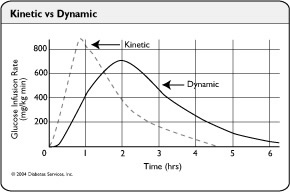Last Updated on September 2, 2025
When Do Humalog and Novolog Insulins Really Work?
Many people assume that rapid insulin works faster than it actually does. For example, someone may feel fine at 80 mg/dl (4.4 mmol), take a meal bolus, and shortly afterward experience shaking, sweating, or difficulty thinking. This can create the false impression that the newly injected insulin is responsible for the low. In reality, the cause is often an earlier dose or insulin stacking from overlapping boluses. Even a slight drop in glucose can make a person go from feeling normal to feeling low, which is why it’s important to understand how rapid insulin truly acts in the body.
Kinetics Versus Dynamics with Insulin (True Rapid Insulin Action)

The kinetics of insulin show when an insulin dose appears in the bloodstream. Insulin dynamics (aka pharmacodynamics) show how long insulin lowers the glucose. After an injection or bolus, peak Humalog and Novolog insulin levels occur about 50 minutes later in the bloodstream. The dashed line on the left within the graphic shows kinetics. However, how insulin impacts your glucose is not nearly this quick. The longer solid line for dynamics to the right illustrates how long the insulin lowers glucose. A maximum reduction in glucose occurs over 2 hours after the dose and continues for another 5 hours.
Another situation also contributes to many of the impressions that rapid insulin is rapid. This occurs when a carb or correction bolus is given, and low glucose begins only an hour later. Here, rapid insulin is an unlikely cause of the low glucose. Instead, the rapid drop in glucose originates from a carb or correction bolus that was too large or from unanticipated activity.
For instance, if enough Novolog is taken to cover 100 grams of carbohydrates, but only 50 grams are actually eaten, the excess insulin causes the blood glucose level to rise quickly. The lack of carbs might give a false impression that insulin acts quickly. Another contributor, insulin stacking, occurs when one bolus overlaps with another given within the last 5 hours. An excess in basal or long-acting insulins can also contribute to stacking.
When low glucose occurs less than 3 hours after a meal or a correction dose is given, consider its cause carefully. There may be an error in carb counting, an overlap of two or more boluses, an excessive basal insulin dose, excess physical activity, a low glycemic index carbohydrate, or another factor, such as delayed gastric emptying from gastroparesis, that is responsible. Remember to note a reason for all unexpected lows and highs in your record book.
See also: Humalog & Heat, User’s Reports, and Insulin Action Time
For additional information on Humalog and intensive management, carbohydrate counting, glycemic index, proper insulin doses, or exercise, get Pumping Insulin by John and Ruth, or Using Insulin by John, Ruth, and C Varma, MD, T Bailey, MD.
